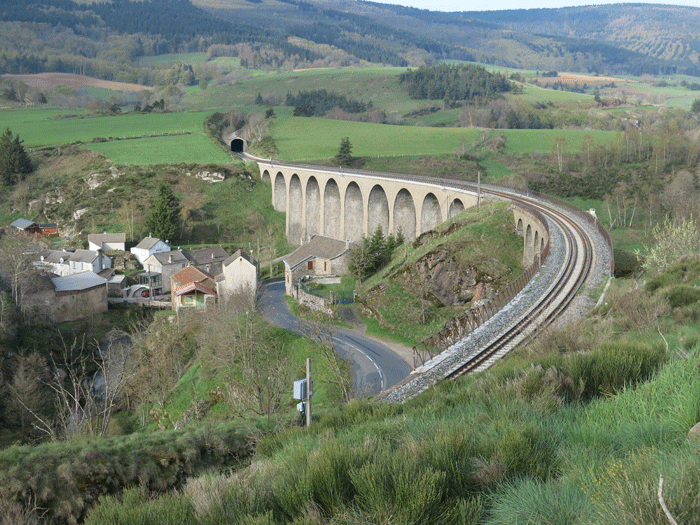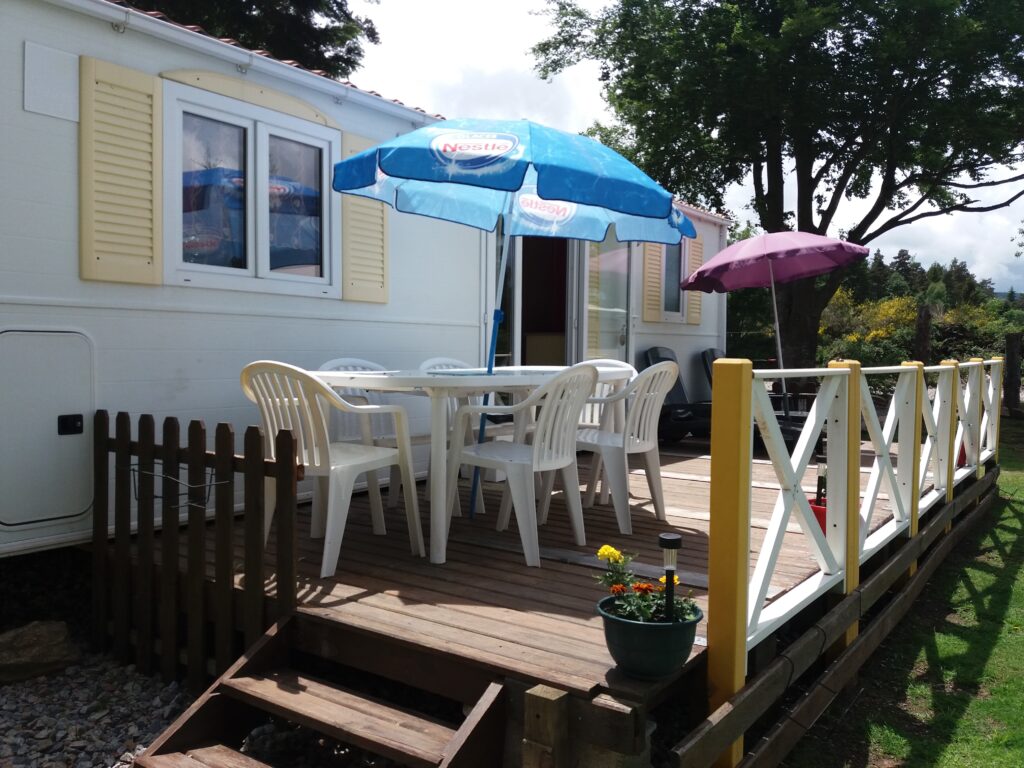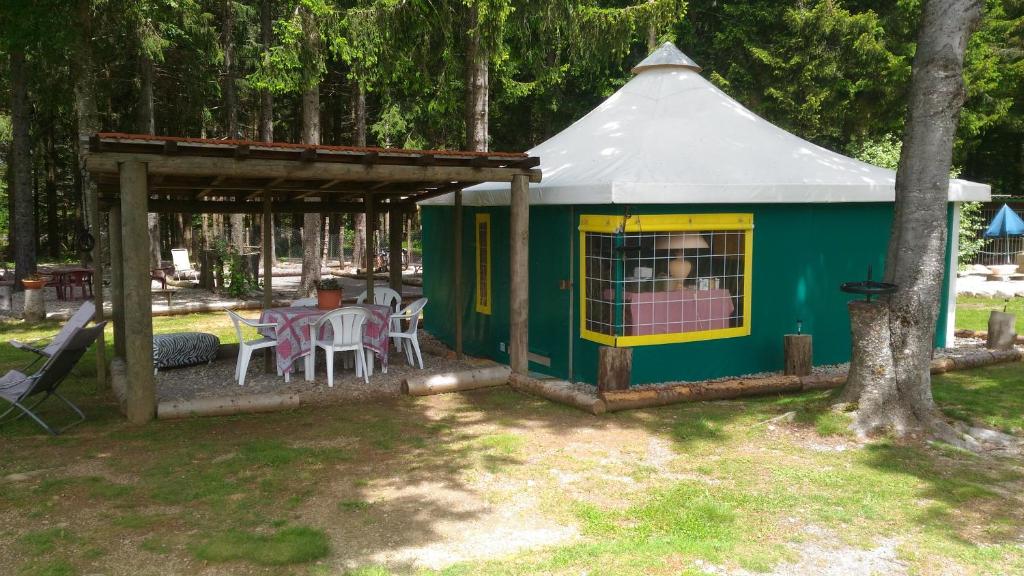* * * *

* * * *
The last post saw we three hikers make it from La Bastide-Puylaurent down to another camp-in-cabins place called Le Sous Bois De Jade. (Despite some confusion in and around the little town of Chasseradès.) Estimates of the distance we should have hiked ranged from 5.1 to 6.9 up to 7.64 miles. We ended up clocking in at 8.2 miles, “mostly because we wandered around town a bit, asking for directions.” But we got some help from a nice “young” couple in town.
(Young meaning about our age group, 72 to 78.)
Our next goal was Hôtel Restaurant La Remise in Le Bleymard. (“And beyond.”) Bleymard is where “Stevenson ate in the village on the evening of 28 September 1878 before camping nearby.” For us there was another confusion about mileage. The initial estimate was 11.2 miles, but Google Maps put the distance from Chasserades at 8.2 miles. The Le Puy guidebook put it at 10.56 miles, passing through L’Estampe and Les Alpiers. But here’s what I wrote that night: “Today we made Bleymard, from Chasserades. A mere nine miles but it felt like more. Slow going in the morning… Like 1.3 miles an hour at first, but we picked up speed later in the day…”
And finally, just in time for Mont Lozere tomorrow. [I found a hiking staff] on the Trail today. Hiking poles are a pain to carry, and to get past TSA [at the airport] but they come in handy sometimes, say, hiking up a steep mountain with lots of slippery rocks. “The Camino provides.” Or the Chemin Stevenson, whatever. Good night, from Bleymard…
“Which is being interpreted:” I generally try not to use a hiking pole, though sometimes they come in handy. On both this hike and the Way of St. Francis in 2022 I found a nice five-foot staff just lying along the trail. And for this trip, just in time for the steep rocky paths I was about to face on Mont Lozere. But then there was that incident in Rome at the end of the 2022 hike.
We’d been out in the wilds, away from all mankind, when all of a sudden we were packed in on crowded middle-of-Rome city sidewalks. I still had that long staff, plus Tom asked me to carry the fancy-schmancy pole he’d managed to sneak past TSA on the flight to Rome. (So he could check his bearings with his phone.) I didn’t want to carry two poles, so I stuck Tom’s through my pack-straps, down around my lower back. Unfortunately that left the pointy end sticking out, as we stood at an intersection waiting for the green hand to cross. Somehow the pointy end of that hiking pole stuck a bystander-local pretty good, and he let loose a string of epithets including a number of good American f-bombs. I was impressed with his language skills but got the hell across that intersection and away from him fast. Not an experience I want to repeat.
Anyway, aside from slow going and finding a hiking staff on the trail, the day’s hike to Bleymard was routine. There was that scenic view, of a rail track built on top of an old Roman aqueduct, shown at the top of the page. On that section we had to hike down the trail, then underneath the high track and through the bitty cluster of buildings, then on to and over that long ridge – that “steep mountain” – off in the distance. (Which was but a foretaste…)
We were settling into a routine, and that September 26 hike to Bleymard marked the fifth of those six straight days of hiking. (Where usually we try to take a day off after four days’ hiking.) The next day, September 27, we faced a 12 mile hike to Le Pont-de-Montvert. (The town of “Greenhill Bridge,” to which Tom’s itinerary added “Sud Mont Lozere.”) We were scheduled to stay two nights at “Le Maison de Voyageurs.” In other words, a second day off from hiking.
But first we had to hike up and over Mont Lozère, “a massif 5,574 ft above sea level … within the Cévennes National Park.” (What the guidebook from Le Puy called Sommet de Finiels.)
We had a wonderful second day off in Montvert but there was no Wi-Fi. (As Wikipedia spells it.) So I had to wait until we got to the one-bedroom cottage in Saint-Julien-d’Arpaon to post this:
A report from St. Julian d’Arpaon, in the Cevennes… Pont de Montvert (“Greenhill Bridge”) is a beautiful little town where we took a day of rest Thursday. But no Wi-Fi. It was sandwiched in between two humongous mountain climbs. Mont Lozere on Wednesday, and yesterday, Friday, 13.68 miles up and over “Signal du Bougès.” If I got the spelling right. Yesterday was tougher, it seemed to me. Dragging tail into this place.
To clarify, we hiked to Bleymard on Tuesday, September 26. On Wednesday the 27th we hiked up and over Mont Lozere to Pont-de-Montvert. (And a rugged climb it was.) There we took a second day off from hiking on Thursday, the 28th, and on Friday the 29th we left Montvert for St. Julein, which involved another steep climb, up and over the slightly lower Signal du Bourges.
I’ll talk about the wonderful second day off from hiking in the next post, but for now, “On to Mont Lozere!” As for Stevenson, he reached the summit “the morning of Sunday 29 September, 1878, having spent the previous night camped in the woods beyond Le Bleymard.” He told of a view like “the hazy air of heaven,” and from there looking down he could see “a land of intricate blue hills beneath his feet… These were the Cévennes of the Cévennes.” He also wrote that on a clear day you could see the Mediterranean, but for us the horizon was a bit hazy.
Another site said Mont Lozere was the highest point on the GR 70 and “a popular long-distance path following approximately the route” traveled by Stevenson in 1878. Also, the GR-70 follows “a draille (drove road) across the mountain, marked by montjoies (standing stones).”
And it was quite a hike. So much so that I’ll have to save that for the next post as well. For that next post I’ll have a picture of us finally reaching the top of Mont Lozere, and on the way seeing “this lady and her donkey, a modern day version of Modestine, in the manner of the original R.L. Stevenson hike.” Also about us seeing – atop Mont Lozere – “no trees, no vegetation, like being on top of the world. Awesome views, but to see them you hike all the way up, then all the way back down.” (I figured there was a lesson there somewhere.)
And speaking of the view atop Mont Lozere, and Stevenson saying on a clear day you could see quite a long way, here’s another foretaste. (But I can’t see the Mediterranean. Can you?)
* * * *

* * * *
The upper image is courtesy of Stevenson Trail Bleymard France – Image Results.
As to Mont Lozere, see also Col de Finiels and Col de Finiels – Pic Cassini … AllTrails
The link Signal du Bougès — Wikipédia is in French, but see also Signal du Bougès Map – Peak – Lozère, France – Mapcarta, “Signal du Bougès is a peak in Cans et Cévennes, Arrondissement of Florac, Occitanie and has an elevation of 1,421 metres. Signal du Bougès is situated nearby to the locality La Rouvière and the hamlet Mijavols.”
The full link to the Bleymard lodging, Hôtel Restaurant La Remise – Le Bleymard – Mont Lozère – Cévennes.The full link to the town of Monvert, Le Pont-de-Montvert (Chemin de Stevenson) – I Love Walking In France. See also Walking the GR70 Chemin de Stevenson – I Love Walking In France:
As the path approaches Mont-Lozère and climbs Col de Finiels (the highest point on the walk), the vegetation – and the livestock – disappears. This is a popular ski destination during the winter months and tall rock pillars mounted along the edge of the trail guide travellers through deep snow. But during the walking season, the path is open and exposed to fierce sunshine and biting winds.
In talking about his climb over Mont Lozere Stevenson recalled “stories of the legendary Camisards – local, untrained Protestant peasants who had waged a guerrilla war against the might of the French army 180 years earlier. ‘In that undecipherable labyrinth of hills, a war of bandits, a war of wild beasts, raged for two years between the Grand Monarch with all his troops and marshals on the one hand, and a few thousand Protestant mountaineers on the other.’” He also spoke of Le Pont-de-Montvert, our destination for a day off, as “where the war had begun.” Also:
The village of Le Pont-de-Montvert oozes with historic charm and stories of the war fought by the Camisards in the early eighteenth century are evident around every corner. The buildings identified in Stevenson’s journal are readily identified and it is easy to stand at the entrance to the bridge and imagine an approaching mob of angry farmers, intent on freeing their brothers who were held captive within the tower walls.
For more see Camisards and War of the Camisards involving “Huguenots (French Protestants) of the rugged and isolated Cevennes region.” (From Wikipedia.) “In the early 1700s, they raised a resistance against the persecutions which followed Louis XIV‘s Revocation of the Edict of Nantes, making Protestantism illegal… The revolt broke out in 1702, with the worst of the fighting continuing until 1704, then skirmishes until 1710 and a final peace by 1715. The Edict of Tolerance was not finally signed until 1787.” Meaning the war was still fresh in the minds of locals of both persuasions when Stevenson hiked through the region.
Re: Mileage calculations. As noted before, we rely heavily on Carol’s fancy-schmancy step-counter in making the final calculation at the end of a hiking day. Along with a bit of Dead reckoning, the process of navigational calculation “using a previously determined position, or fix, and incorporating estimates of speed, heading (or direction or course), and elapsed time.”
The lower image is courtesy of Mont Lozere France – Image Results.
* * * *



